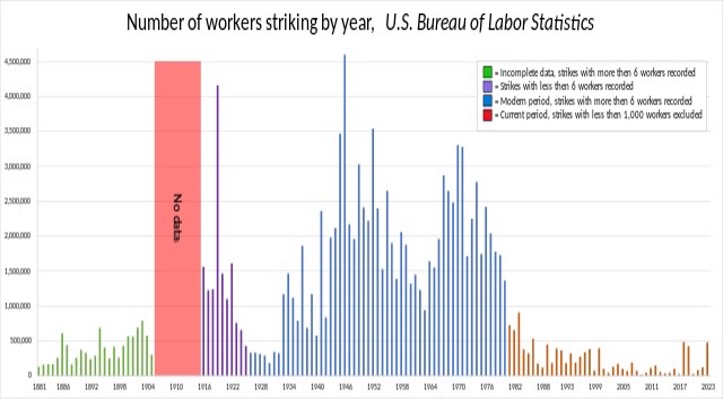
This article has been adapted by the author from his talk at the Strike School event at the IMC on May 5.
For almost two centuries the strike has been the characteristic and most important form of protest for working-class people. Most often, these conflicts are thought about as economic conflicts, struggles for another dollar a day. And often they have been. But strikes can also be a form of defense against obvious oppression and assertion of workers’ humanity. Strikes can even have political ends. The incidence of strikes has varied enormously over US history, having all but disappeared by the end of the twentieth century.
The American labor movement is usually thought about as conservative, and for most of its history, the label seems to fit in political terms. Despite the strength of socialist movements in the late nineteenth and early twentieth century, American workers have largely eschewed the sort of social democratic politics characteristic of most European and other societies
On the industrial side, however, the US movement has been particularly prone to strikes. Throughout the late nineteenth and early twentieth centuries, giant, often violent strikes shook American society: strikes surrounding the Haymarket events in Chicago (1886), the Pullman railway strike and boycott (1894), and titanic struggles in steel, meat packing, mining, and other industries. Strikes were crushed in the early twenties and nearly disappeared for more than a decade amidst open-shop campaigns, welfare capitalism, and mass unemployment in the early thirties. Again, in the late thirties and following World War II, large strikes shook basic industry as workers sought to build new forms of organization: industrial unions embracing all workers in an industry regardless of skill, gender, race, or ethnicity. Labor organization and strikes remained strong throughout the postwar period, then crashed in the late seventies and eighties, all but disappearing in the eighties and nineties. As recently as 2009, less than 13,000 workers were involved in large strikes.
More recently, the strike has reemerged. The half million who struck in 2023 represented a 280% increase over the previous year. That certainly qualifies as an upsurge (though the number and size of strikes had been rising for several years). It is particularly significant that the big strikes of 2023 and early 2024 were launched not only by industrial workers, notably the United Auto Workers, but also nurses, the screenwriters, service workers, and graduate employees. That is, strike activity seems to be reflecting long-term changes in the occupational structure of the labor force.
What accounts for the variation in strike activity over the years and what might we expect in the near future? Obviously, economics make a big difference. Although there are certainly exceptions like the big strikes during the Great Depression, low unemployment improves the prospects for successful strikes. It is simply more difficult for employers to hire strikebreakers. Likewise, inflation’s pressure on wages tends to stimulate strikes. Thus, as inflation has hung on over the past year or so and unemployment has remained low, we have seen more strikes, including some in sectors where they have been rare in the past. If these conditions persist, we can expect to continue to see more strikes.
Politics also matter. Notwithstanding Trump’s populist rhetoric, we can expect a Republican administration to go after strikers and certainly not to support their struggles. If President Biden, who has probably not received enough credit for his pro-labor stance, wins in November, and especially if the Democrats are able to win control of the House, we might expect a better political climate for successful strikes.
Finally, workers’ own consciousness and creativity factor into the equation. With CEO compensation hundreds of times larger than wages, there is a widespread recognition of inequality. Strikes will tend to be aimed at this divide and hopefully generate considerable solidarity among citizens who also object to this level of inequality. The recent United Auto Workers (UAW) strike was not only big but also smart. The union’s demands reflected the situation of the working class, and it garnered considerable public support for very substantial wage increases. The UAW aimed at key plants with a series of rolling strikes, keeping most of their membership working and supporting those who went out.
But labor supporters should not get complacent. The 2023 upsurge is dwarfed by strike numbers in the early seventies when more than three million American workers were on strike. Vast numbers of workers remain beyond the reach of unions. Still, the reemergence of the strike and organizing activity among industrial, service, and white-collar workers is important. Anyone interested in the preservation of democracy in the United States should be encouraged, and the recent strikes do seem to suggest the rebound of a more aggressive movement. American social movements have changed enormously over the past generation and are now often based on racial and sexual identities, but a labor movement that crosses these and other divisions and mobilizes people on shared class interests remains a critical base for opposition to the fascist upsurge over the past decade.

Jim Barrett is a historian of class, race, and ethnicity in the United States and author of History from the Bottom Up and the Inside Out: Ethnicity, Race, and Identity in Working-Class History (2017).
713 total views, 1 views today